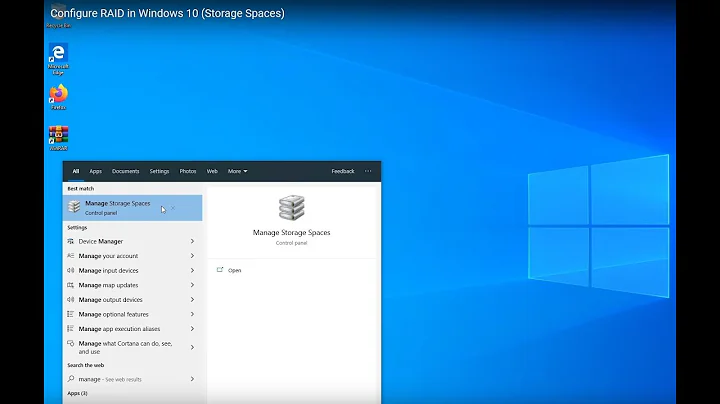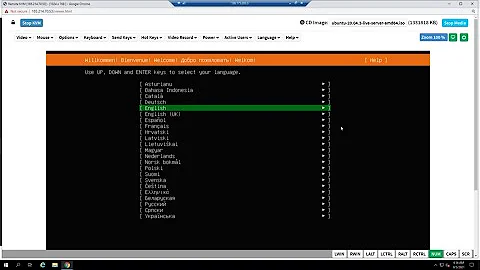Set up raid 1 after OS installation
Solution 1
Those are Intel-based boards, so the ctrl-l you are trying to use to get into the RAID configuration is most like actually ctrl-I (I for Intel).
If you want to go by way of hardware/firmware RAID, then be prepared to make a full Windows backup (using a System Image backup, or an ASR if pre-Vista), set up the RAID, and do a reinstall using the backup.
In the end it's almost always the fastest, safest and most stable method.
Solution 2
If you install the Intel Matrix software, you can convert the existing non-RAID drive to a RAID 1 Mirror without re-installing anything. This is done from within Windows, not from the BIOS screen. It asks which drive's data to keep, so make sure you choose the correct one, such as Drive 0 System.
You would first break your software mirror so the first hard drive is just a stand-alone basic disk with no software mirroring.
Related videos on Youtube
PEmal
Updated on September 18, 2022Comments
-
PEmal over 1 year
I bought 2 Lenovo thinkstation E31 and I want to set up
RAID1 on them.I added a hard drive for each. I went in the BIOS and set it to
RAIDthen I pressedctrl-lto start the raid manager but it disappear after 2 seconds. I don't know if it's because Windows 7 is already installed but in the user manual it says that theRAIDwill only works for windows 7 users so I installed it first with the lenovo partition.I read on forums that setting
RAIDformats the disk but I got the secret partition and I don't wanna lose it. Also, in windows 7 when I go in computer, I don't see the second hard drive and the Intel hard driver manager pops up saying I got an another drive ready.From that, I can set the
RAIDbut will it be a softwareRAID? I would prefer a hardwareRAIDcause it's faster.Does anyone can explain how I could get the hardware RAID or why the
ctrl-lwindows doesn't work. Thank you-
ganesh over 11 yearsFirst of all, why would hardware RAID be faster? This used to be true for RAID levels which needed relative expensive calculations (e.g. RAID5), but RAID 1 is just a straight copy of the data. Second: Yes, you can set up software RAID, but make sure you RAID all parts you want. (e.g. only a partition in RAID will make your data safer and faster to read. But if your boot part is not in the RAID then you get 50% chance to boot after a disk failure. (Note that the data would still be safe in that case, but you still end up reinstalling the OS).
-
PEmal over 11 yearsI think the RAID 1 is the best for me, it's a server and all I want is that it's 100% online with all the data with 2 disks. Do you know why I don't have access to the Intel Matrix Storage Manager with ctrl-l. I can see it for 1 sec then it disappear. Thank you for the clarifications.
-
-
PEmal over 11 yearsI noticed it was ctrl-I but I realized I would have to format so I used the intel software to do a software raid. is it really less stable
-
PEmal over 11 yearshow is it less stable?
-
 Ƭᴇcʜιᴇ007 over 11 yearsWhat I meant was that it'd be more stable to do a full backup and restore to the new drive configuration (with the new drivers) vs. shoe-horning them in after the fact. There's also considerably less (no) chance of screwing up live system partitions (and such) by using the backup/restore method. If you used the Intel console in Windows to just click yourself together a RAID, then it seems that someone already installed the drivers, and it sounds like they had your BIOS in RAID mode already. So if that's the case, then you should be good to go. :)
Ƭᴇcʜιᴇ007 over 11 yearsWhat I meant was that it'd be more stable to do a full backup and restore to the new drive configuration (with the new drivers) vs. shoe-horning them in after the fact. There's also considerably less (no) chance of screwing up live system partitions (and such) by using the backup/restore method. If you used the Intel console in Windows to just click yourself together a RAID, then it seems that someone already installed the drivers, and it sounds like they had your BIOS in RAID mode already. So if that's the case, then you should be good to go. :) -
PEmal over 11 yearsyeah Intel software pop when I set the raid in the bios. I didn't know I had to set the raid in the bios for a software raid. It was an accident when I tried to do a hardware raid. Thank you




